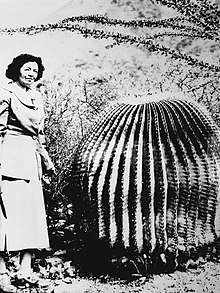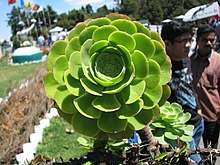Helia Bravo Hollis
| Helia Bravo Hollis | |
|---|---|
 Helia Bravo Hollis in the Botanical Garden that bears her name | |
| Born |
30 September 1901 Mexico City, Mexico |
| Died | 26 September 2001 (aged 99) |
| Nationality | Mexican |
| Education |
Master of Science, UNAM Honorary Doctorate, UNAM |
| Occupation | botanist |
Helia Bravo Hollis (30 September 1901 – 26 September 2001) was a Mexican botanist, distinguished with the titles of Emeritus Researcher and honoris causa doctorate by the UNAM. For many years she developed her scientific research at the Faculty of Sciences of the same university.[1]
Background and Studies
She was born and raised in the neighborhood of Mixcoac, in Mexico City. Her interest in the study of living beings came from Sunday walks with her parents.
Though the Mexican Revolution conflicts affected her family, she made progress with her studies and entered high school in 1919.
Saint Ildefonso (National Preparatory High School), in Mexico City, was a very interesting institution for her, with professors like Vicente Lombardo Toledano, Sotero Prieto, Erasmo Castellano, Antonio Caso, and Isaac Ochoterena, who influenced Bravo's interest in the biological sciences.
Successfully finishing high school, she continued her studies in medicine, as there was pressure from her family to become a doctor and biology was not available as a major at the UNAM. However, an opportunity to study biology arose a year afterwards, and she transferred to study at the College of Sciences of the same university.
In 1931, she obtained the degree of Master of Science in Biological Sciences from the College of Philosophy and Letters of the UNAM, with the thesis Contribution to the knowledge of the cactus of Tehuacán, Puebla[2]. She received an honorary doctorate from UNAM in 1985[2].
Contributions to Biology
Bravo worked in the field of zoology in the area of parasitic and free-living protozoa, publishing nine studies between 1921 and 1927 while still a student alongside Professor Isaac Ochoterena. She joined the teaching faculty at the National Preparatory School as a teaching assistant, and later as a professor.
She is invited to head the Biology Department of the UNAM, which has changed its name to "Instituto de Biología de la UNAM" after the University became autonomous in 1929.
In the 1950s, she returned to academic life and was a professor of Botany at the National School of Biological Sciences of the Instituto Politécnico Nacional. Two years later she returned to the Instituto de Biología at UNAM. It is during this period that she shared the leadership of the National Herbarium with Débora Ramírez Cantú.

She made contributions to the area of floriculture, although in the arid regions of eastern Mexico, she focused on the taxonomy of cactaceae. She organized a collection of live cactaceae and other succulent plants in order to observe their development and evaluate morphological characteristics.
She co-founded the Mexican Cactus Society (Sociedad Mexicana de Cactología) in 1951, and later helped to found the Botanical Gardens at UNAM in 1959, serving as its director in the 1960s. She specialized in the taxonomy of cactacea in Mexico, authoring an entire monograph on the Mesoamerican region. She conducted fieldwork and worked in herbariums, disseminating her findings in publications, conferences, and in the classroom.
Her scientific writings span over 160 publications, 60 taxonomy descriptions, and 59 reclassifications. Bravo published her first book in 1937.[4]
Honors
Bravo obtained several distinctions as well as national and international recognitions. She received the Cactus d'Or Award from the International Organization for Succulent Plant Study (IOS) in 1980[2]. The last award she received was for her work regarding the flora of Metztitlán, Hidalgo, during the creation of the Reservation of the Biosphere in 2000.
The Helia Bravo Hollis Botanical Garden in Puebla, Mexico was named after her and is home to many endangered cactus species[4].
Eponymy
Nine taxa of the flora and fauna of Mexico have been appointed in her honor, including:[5]
- (Cactaceae) Heliabravoa Backeb. -- Cact. Succ.
Tribute
On 30 September 2018, search engine Google commemorate Helia Bravo Hollis with a Doodle.[6]
References
- ↑ Urs Eggli; Leonard E. Newton (29 June 2013). Etymological Dictionary of Succulent Plant Names. Springer Science & Business Media. pp. 31–. ISBN 978-3-662-07125-0.
- 1 2 3 Staples, Chuck. "Helia Bravo Hollis Biography" (PDF).
- ↑ IPNI. Bravo.
- 1 2 "Women in Botany: Helia Bravo Hollis (1901 - 2001)". The Femmes of STEM. Retrieved 2018-08-19.
- ↑ J. Gr. Brit. 18: 23. 1956
- ↑ "Helia Bravo Hollis' 117th Birthday". Google. 2018-09-30. Retrieved 2018-10-03.
External links
- The Succulent. Homage of Jesusa Rodriguez and Liliana Felipe to Helia Bravo Hollis